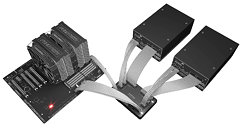- Joined
- Oct 9, 2007
- Messages
- 47,675 (7.43/day)
- Location
- Dublin, Ireland
| System Name | RBMK-1000 |
|---|---|
| Processor | AMD Ryzen 7 5700G |
| Motherboard | Gigabyte B550 AORUS Elite V2 |
| Cooling | DeepCool Gammax L240 V2 |
| Memory | 2x 16GB DDR4-3200 |
| Video Card(s) | Galax RTX 4070 Ti EX |
| Storage | Samsung 990 1TB |
| Display(s) | BenQ 1440p 60 Hz 27-inch |
| Case | Corsair Carbide 100R |
| Audio Device(s) | ASUS SupremeFX S1220A |
| Power Supply | Cooler Master MWE Gold 650W |
| Mouse | ASUS ROG Strix Impact |
| Keyboard | Gamdias Hermes E2 |
| Software | Windows 11 Pro |
Phanteks today announces the release of their patented Power Combo. The Power Combo is design to maximize your power output by allowing you to connect two power supplies. The Power Combo will be a true plug and play that requires no splicing and cutting of the wires. The Power Combo is design to be safe and secure. The Power Combo features a redundant power supply architecture concept, this prevents the system from shutting down when one power supply fails. This ensures that all your vital information and data will not be interrupted or lost.
The Power Combo can run high end systems that requires more power output by combining 2x top tier PSUs. The Power Combo is fully compatible to Mini ITX, mATX, ATX, and E-ATX motherboards. The Power Combo features a unique soft start circuit that limits the inrush current to help improve stability and reduce transient voltage drops. The Power Combo will help share the load current of the two power supply and improve the power efficiency. The Power Combo is cost efficient and provides maximum power and efficiency.


Available from April 2016, The Power Combo will be priced at €39.90.
View at TechPowerUp Main Site
The Power Combo can run high end systems that requires more power output by combining 2x top tier PSUs. The Power Combo is fully compatible to Mini ITX, mATX, ATX, and E-ATX motherboards. The Power Combo features a unique soft start circuit that limits the inrush current to help improve stability and reduce transient voltage drops. The Power Combo will help share the load current of the two power supply and improve the power efficiency. The Power Combo is cost efficient and provides maximum power and efficiency.


Available from April 2016, The Power Combo will be priced at €39.90.
View at TechPowerUp Main Site





